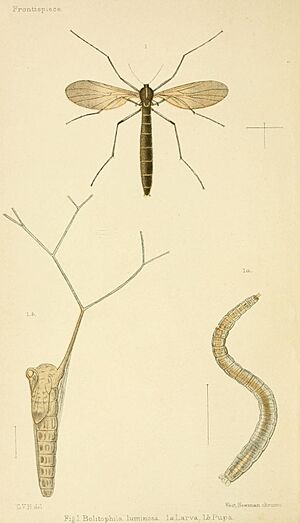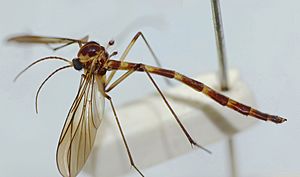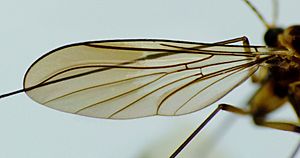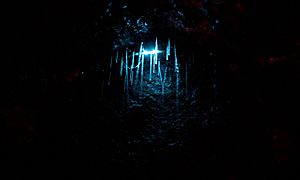Arachnocampa luminosa facts for kids
Quick facts for kids Arachnocampa luminosa |
|
|---|---|
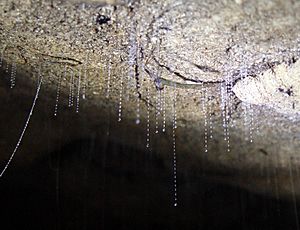 |
|
| Glowworm (Arachnocampa luminosa) and silk snares | |
| Scientific classification | |
| Kingdom: | |
| Phylum: | |
| Class: | |
| Order: | |
| Family: |
Keroplatidae
|
| Genus: | |
| Species: |
A. luminosa
|
| Binomial name | |
| Arachnocampa luminosa (Skuse, 1891)
|
|
| Synonyms | |
|
|
The Arachnocampa luminosa is a special insect from New Zealand. Most people call it the New Zealand glowworm or just glowworm. It's actually a type of fungus gnat.
What makes it super cool? Both the young glowworm (called a larva) and the adult insect can make their own light! This light is a beautiful blue-green color. Glowworms love to live in dark, damp places like caves. You can also find them on sheltered banks in native forests where it's very humid. Their Māori name is titiwai, which means "projected over water."
People first wrote about these glowworms in 1871. They were found in a gold mine in the Thames area of New Zealand. At first, people thought they were like the European glowworm beetle. But in 1886, a teacher from Christchurch figured out they were actually the larvae of a gnat, not a beetle.
The glowworm got its official scientific name, Bolitiphila luminosa, in 1891. Later, in 1924, scientists gave it a new genus name: Arachnocampa. This name means "spider-worm." They chose this name because the glowworm builds a silk nest and uses sticky silk threads to catch its food, just like a spider!
Contents
Where Do Glowworms Live?
Arachnocampa luminosa glowworms are found all over New Zealand. You can see them on both the North Island and the South Island. They usually live in cave systems or in native forests. These places have lots of small insects for them to eat and high humidity, which they need to survive.
Some places have become very popular for tourists who want to see these amazing glowworms. Famous spots include the Waitomo, Waipu, and Te Anau caves. You can also find them in natural areas like the Wellington Botanical Gardens.
Life Cycle of a Glowworm
The glowworm's life starts as a tiny, round egg. These eggs are about 0.75 millimeters wide. Female glowworms usually lay them right on the cave wall.
When a baby glowworm (larva) hatches, it's shaped like a cylinder and starts glowing right away! At first, they are only about 3 to 5 millimeters long. But over several months, they grow much bigger, reaching 30 to 40 millimeters. The larva might move around a bit before choosing a good spot to build its silk nest. Most larvae hatch in the spring.
How Larvae Catch Food
The larva spins a special nest made of silk on the cave ceiling. From this nest, it hangs down up to 30 sticky silk threads. It puts small, sticky droplets along each thread. These threads are like a trap!
Glowworms mostly catch other small flies, especially tiny midges. If a glowworm lives outside a cave, it might also trap spiders or other small creatures that can't fly. When an insect gets stuck in a sticky thread, the larva pulls the thread up. It does this by slowly eating the thread. Then, it starts to eat its prey, often while it's still alive.
From Larva to Adult
After growing through five stages (called instars), the larva gets ready for its next big change. It hangs upside down on a long silk thread and turns into a pupa. This change takes about 24 hours.
The pupa stage lasts for about two weeks. During this time, the pupa continues to glow. However, male pupae eventually lose their glow. The adult glowworms that emerge from the pupae are not very good at flying.
Adult glowworms usually appear during the winter. Females live for up to 76 hours, and males can live up to 96 hours. Females typically lay over 100 eggs. These eggs usually hatch after about 20 days, and then the whole life cycle starts again!
Dangers for Glowworms
Glowworms face some dangers in their environment. Other creatures that live in caves, like harvestmen (a type of spider-like animal), sometimes eat them. There are also tiny fungi that can cause diseases in glowworms. Sometimes, adult glowworms might even get caught in the sticky threads of other larvae. This can lead to them being eaten, but scientists are still studying how often this happens.
How Glowworms Make Light
The larvae of these glowworms glow to attract prey into their sticky threads. It's like a tiny, glowing fishing lure! The light they make is brightest at a specific blue-green color.
Like other animals that make their own light (this is called bioluminescence), glowworms create their glow using a special chemical reaction. They have an enzyme called luciferase. This enzyme acts on a small molecule called luciferin. This reaction happens in special organs in their abdomen called Malpighian tubules.
The luciferase enzyme in glowworms is similar to the one found in fireflies. However, the luciferin molecule that the enzyme works on is completely different from what fireflies use. It's also different from other known bioluminescent systems.
The pupae and adult glowworms also make light, but scientists aren't completely sure why. One idea is that the light helps adult males find females to mate with. But there isn't much proof for this idea yet. It's also possible that the light in adults is just a leftover from their larval stage. This is because the Malpighian tubules (where the light is made) don't change much when the glowworm transforms from a larva to an adult.
Images for kids


